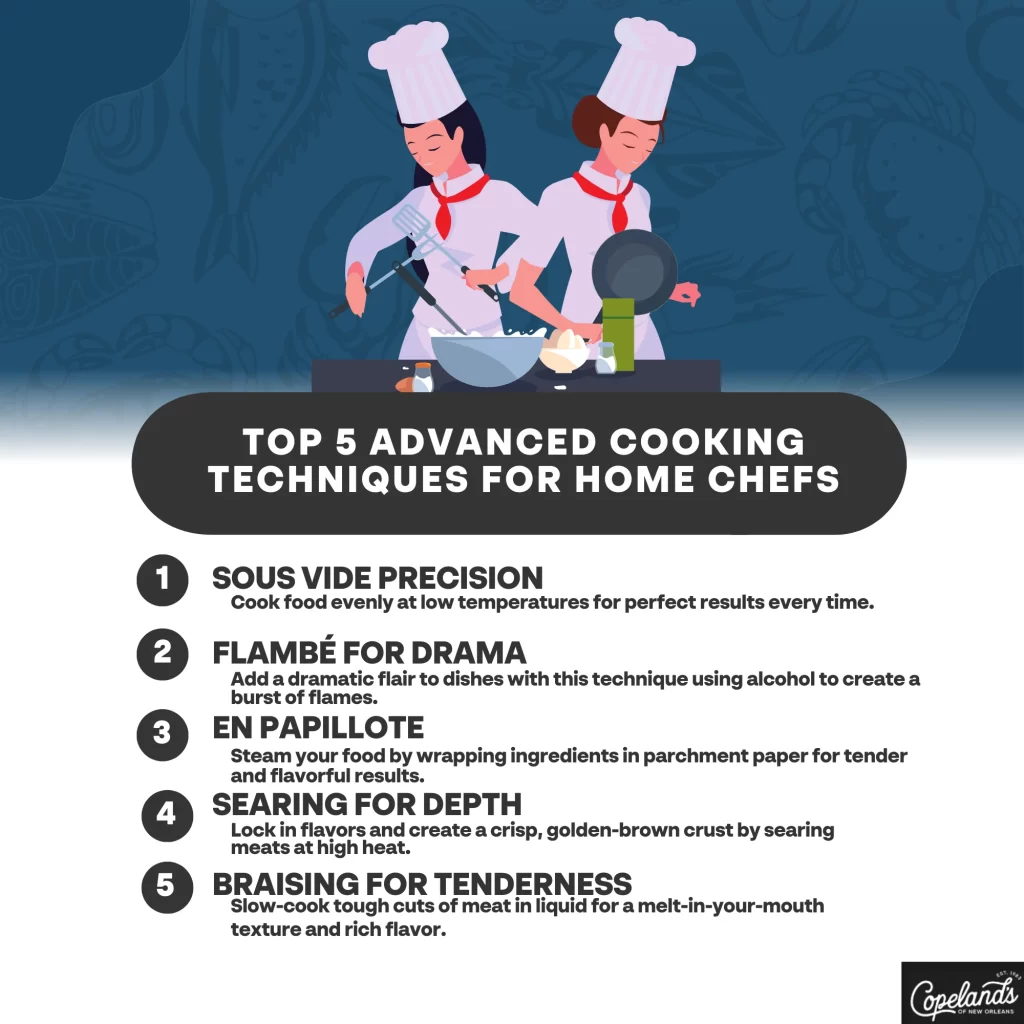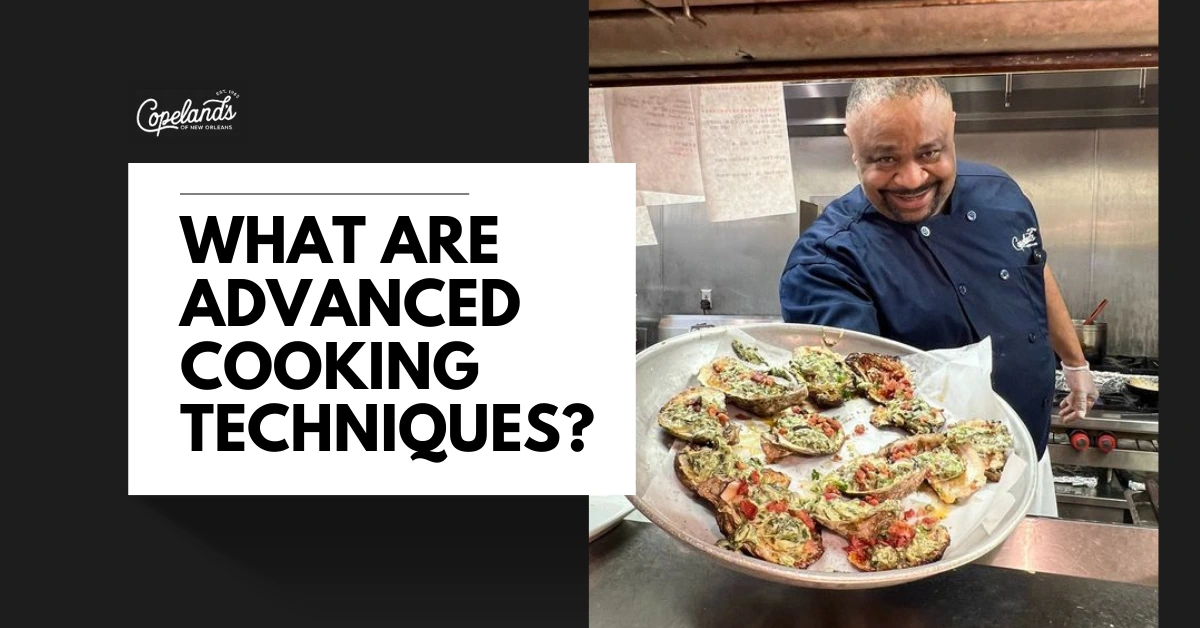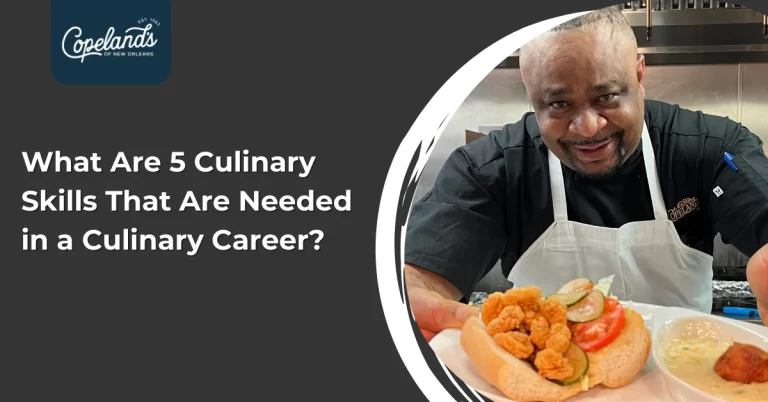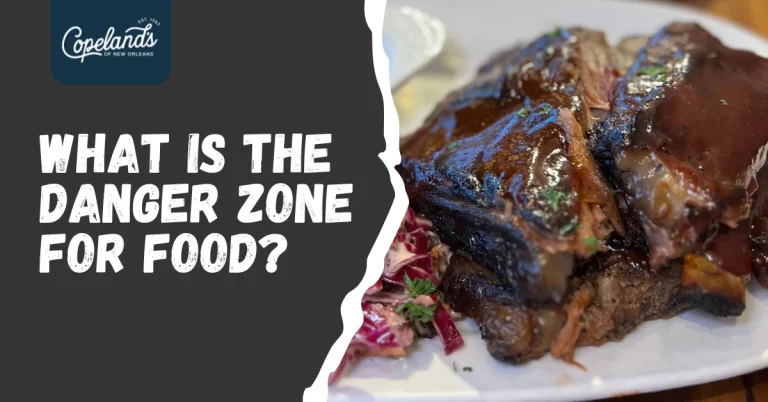Advanced cooking techniques are refined culinary methods that can dramatically elevate your dishes. They include sous vide, a style of precision cooking under vacuum-sealing that guarantees consistent results and enhanced flavors. En Papillote deals with sealing food in parchment for baking, a method that intensifies flavors and retains moisture. The theatrics of flambé add an impressive dimension, caramelizing and reducing spirits to reveal diverse flavors. Au Gratin introduces a crunchy top layer to your dish, while Bain-Marie offers gentle heat control for delicate meals. As you venture deeper into these techniques, you’ll unfold transformative ways to reinvent your cooking.

Key Takeaways
- Advanced cooking techniques like En Papillote use steam to intensify flavors and ensure moisture in baked dishes.
- Techniques such as Flambé enhance flavors through caramelization and reduction, providing a theatrical cooking presentation.
- Techniques like Au Gratin involve browning cheese or breadcrumbs under a broiler, adding depth and complexity to dishes.
- Bain-Marie, a precise and gentle heating method, is used for melting chocolate and making custard, enhancing texture and flavor.
- Sous Vide involves vacuum-sealing food for precision temperature control, ensuring consistent results and enhanced flavor retention.
Preparing for Your Culinary Adventure
Before starting your culinary journey at New Orleans Scratch Kitchen, it’s vital to prepare yourself for a chef-driven approach to classic cuisine.
You’ll be dealing with the best of both worlds – advanced cooking techniques seamlessly blended with traditional cooking methods that have stood the test of time.
It’s important to understand that advanced cooking techniques aren’t just about complex maneuvers with a chef’s knife or mastering the sous-vide.
It’s about extracting the deepest flavors, achieving perfect textures, and presenting dishes in innovative ways. From low-temperature roasting to precision searing, each method is designed to elevate your dining experience.
Equally significant, don’t overlook the importance of traditional cooking techniques.
They form the foundation of the kitchen’s philosophy, bringing out the authentic flavors that New Orleans is known for. Techniques like slow braising and Creole seasoning are deeply ingrained in the kitchen’s operations.
They guarantee that each dish retains its distinctive taste while embracing modern culinary innovations.
In essence, the New Orleans Scratch Kitchen is a fine balance between the past and the present.
It’s a culinary adventure that demands you to appreciate the delicate interplay between advanced and traditional cooking techniques.
Embracing the Art of En Papillote
Embracing the art of en papillote is akin to inviting a culinary tradition into your home, a tradition that has been cherished for its ability to meld flavors and preserve moisture.
As one of the more advanced cooking techniques, it presents an opportunity to elevate your culinary prowess.
En papillote, a French term meaning ‘in parchment’, involves sealing food, typically fish or vegetables, in a pouch before baking. This method traps steam, intensifying flavors and ensuring a moist, tender result.
It’s not just a cooking technique, it’s an art form, demanding careful folding and sealing of the parchment.
Moreover, it’s among the healthy cooking techniques, as it requires minimal fat. You’re not frying or sautéing, but steaming within the pouch, allowing the ingredients to cook in their own juices. This preserves nutritional value, making it a diet-friendly choice.
Mastering en papillote can be a game-changer. It’s a demonstration of your technical skills, patience, and creativity in the kitchen.
It’s about more than just cooking—it’s about crafting an experience, a symphony of flavors revealed when the pouch is cut open.
It’s a technique worth embracing, a tradition worth continuing.
The Dramatic Flair of Flambé
Imagine setting your pan ablaze, bathing your dish in a brilliant flame that dances and flickers, transforming your kitchen into a personal stage. This is the dramatic flair of flambé, an advanced cooking technique that never fails to infuse your culinary creations with an air of showmanship.
This professional cooking technique isn’t just about the spectacle. It’s an opportunity to enhance flavors and create a unique culinary experience.
Here are three reasons why flambé should be on your cooking techniques list:
- Enhanced Flavors: The flame helps to caramelize sugars and reduce sauces, amplifying the depth and complexity of your dishes’ flavors.
- Theatrical Presentation: Nothing engages your guests quite like a dish prepared with fire. It’s a sure-fire way to turn a meal into a performance.
- Culinary Adventure: Flambé encourages you to step out of your comfort zone, allowing you to experiment with different spirits and ingredients.
Flambé, with its dramatic presentation and ability to elevate your dishes, embodies the essence of advanced cooking.
It’s time to ignite your culinary passion, and let your kitchen flare with the dramatic art of flambé.
The Classic Touch of Au Gratin
Dipping your spoon into a warm, creamy dish topped with a golden, crispy crust, you encounter the classic touch of Au Gratin. This traditional French cooking technique involves sprinkling a layer of cheese or breadcrumbs over a dish, then browning it under a broiler.
It’s a technique that requires mastery to achieve that perfect blend of creaminess and crunch. As an aspiring chef, you’ll find Au Gratin to be one of the different cooking techniques that add depth and complexity to a dish.
The key lies in the balance between the ingredients underneath and the topping. Too much cheese and the dish can become heavy; too little, and it lacks that signature gratinated crust.
The thickness of the topping layer, the choice of cheese, the intensity of the heat, and the broiling duration are all variables in this technique. These are among the cooking techniques to master, and perfecting them will greatly raise your culinary game.
Mastering the Bain-marie
While you may not be immediately familiar with the term, the Bain-marie technique is an essential one to master in the kitchen. A fundamental part of many advanced and basic cooking techniques, Bain-marie introduces a level of precision to your techniques of cooking.
Originating from ancient alchemist practices, Bain-marie uses the principle of gentle heat. You place a container (like a baking dish or bowl) of food in a larger, shallow pan of hot water. This allows the food to cook more slowly and prevent curdling, drying out, or burning.
Here are three reasons this technique is so rewarding:
- Control: Unlike direct heat, Bain-marie gives you more control, reducing the risk of overheating.
- Versatility: From melting chocolate to making custard, it’s a versatile technique.
- Quality: It enhances the texture and flavor of delicate dishes.
Mastering the Bain-marie technique requires practice and patience.
But once mastered, it opens up new possibilities in your culinary adventures.
Sous Vide: Precision Cooking at Home
Just as the Bain-marie technique brings a meticulous approach to the kitchen, sous vide cooking elevates precision to an art form.
Originating from French, ‘sous vide’ translates to ‘under vacuum’, reflecting the method of vacuum-sealing food in a bag, then cooking it to a very precise temperature in a water bath.
Unlike many traditional cooking techniques, sous vide provides unprecedented control over your results.
You’re no longer guessing when your steak is a perfect medium-rare or if your chicken has reached a safe temperature.
The precision of sous vide means you get consistent results, every single time.
Sous vide is also one of the new cooking techniques that can make foods more flavorful.
Because your food is sealed in a bag, none of the flavor escapes to the cooking medium.
Spices, herbs, and marinades all impart more intense flavors directly to the food.
Sous vide may seem intimidating at first, but it’s actually quite simple to get started.
With a sous vide precision cooker and a pot of water, you’re ready to take your culinary skills to the next level.
Expanding Your Culinary Skill Set
Beyond the domains of traditional cooking lies the exhilarating world of advanced culinary techniques. These aren’t just for professional chefs; you too can expand your culinary skill set and revolutionize your home cooking.
- Mastering Advanced Cooking Techniques: Don’t be intimidated by these more complex procedures. Techniques like sous vide, molecular gastronomy, or fermentation might seem intimidating, but they’re simply different types of cooking techniques that, when understood and practiced, can elevate your dishes to new heights.
- Experiment and Create: Embrace the unknown. Challenge yourself to try unfamiliar cooking techniques, incorporate new ingredients, or even create your own recipes. This not only expands your culinary toolkit but also sparks creativity in the kitchen.
- Continuous Learning: The culinary world is vast and ever-changing. Keep up-to-date with the latest food trends, techniques, and technologies.
Attend cooking workshops, watch online tutorials, or read up on chef memoirs. You’ll be surprised by how much you can learn.
Frequently Asked Questions
What Are the Benefits of Using the Sous Vide Cooking Method?
You’ll find sous vide cooking beneficial as it guarantees even, precise cooking. It eliminates overcooking risks, maintains the food’s nutrients and enhances flavor by locking in juices. It’s a foolproof method for perfect results.
How Does the Bain-Marie Technique Affect the Texture of the Food?
The bain-marie technique lets you gently cook delicate dishes. It prevents overheating, thereby maintaining a smooth texture. You’ll find it invaluable for custards, mousses, and sauces that need careful handling to prevent curdling or breaking.
What Safety Measures Should Be Taken When Flambéing Dishes at Home?
When flambéing dishes at home, you should always keep a fire extinguisher handy. Don’t pour alcohol directly from the bottle and never leave your flambé unattended. Always turn off the flame before igniting your dish.
How Does the En Papillote Method Enhance the Flavor of the Food?
When you cook en papillote, you’re fundamentally steaming food in its own juices. This technique locks in flavor and moisture, allowing the ingredients’ natural essences to intensify, creating deliciously aromatic and concentrated dishes.
Can Au Gratin Preparation Be Used for Both Meats and Vegetables?
Yes, you can use au gratin preparation for both meats and vegetables. It’s a versatile technique that involves baking ingredients under a crispy, browned topping, usually breadcrumbs or cheese, adding texture and depth to your dishes.
Conclusion
So, you’ve waltzed through the world of en papillote, flambéed like a pro, and mastered the bain-marie. Who knew that becoming a culinary wizard would be this easy? Now, with sous-vide in your arsenal, your kitchen might just outshine a Michelin-star restaurant. Remember, in cooking, as in life, the journey is the destination. So, keep exploring, keep learning, and above all, keep cooking. After all, who needs a fancy restaurant when they’ve got you?




